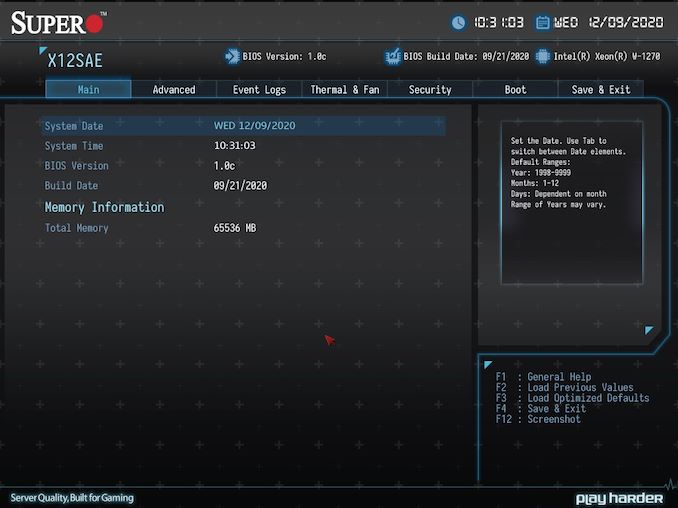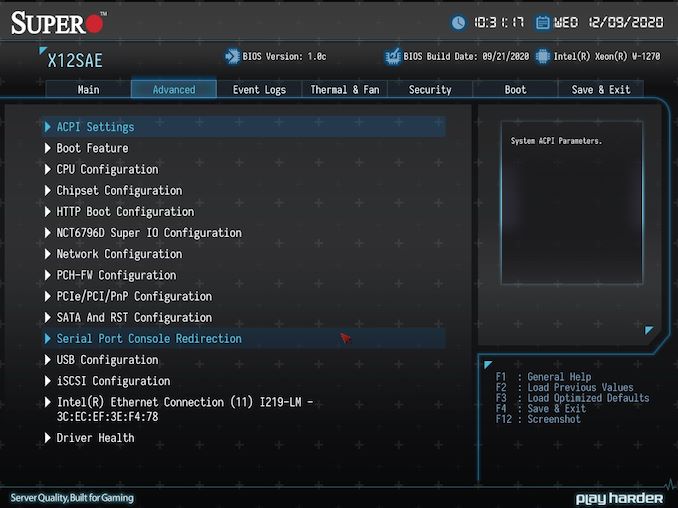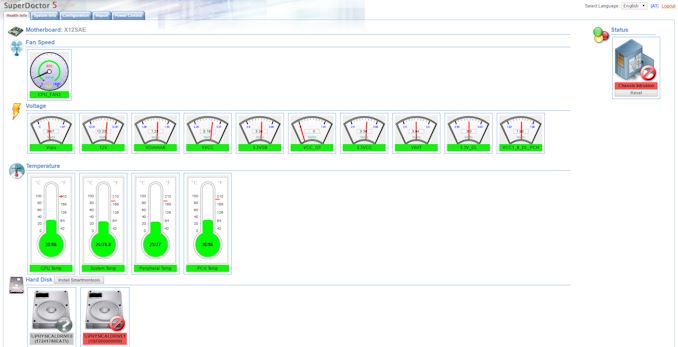Supermicro X12SAE W480 Motherboard Review: For Xeon W-1200 Workstations
by Gavin Bonshor on December 11, 2020 9:30 AM ESTBIOS
The Supermicro X12SAE is using its more consumer-friendly SuperO firmware and not the Aptio based firmware. The SuperO UEFI firmware is using a black and grey user interface, with plusses that resemble keyboard switches throughout the background. It is using a mixture of blue and turquoise text, with deeper royal blue highlighting to signify which option is currently selected. In the bottom right hand corner of the GUI, is a key index that includes a help menu that can be accessed by pressing F1, with simple and easy ways to revert back to default settings by pressing F2.
The initial screen upon entering the BIOS is a very simple layout with a list of basic information. This includes the system date, time, the firmware version the board has installed on the 256 MB chip, as well as the date the BIOS build was released. Underneath this is the memory information which is a little archaic, and only displays the capacity as opposed to the current settings.
Along the top is a list of the menus which consists board's advanced settings, event logs, thermal and fan, the security options, the boot menu, and the typical save and exit menu. The advanced menu incorporates all of the CPU and chipset options, as the Supermicro X12SAE doesn't support overclocking. This also includes all the current W480 models, as the supported Comet Lake Xeon W-1200 processor cannot be overclocked. With that in mind, the advanced section includes submenus which include chipset configuration, enabling and disabling CPU specific features such as Hyper-Threading, AES, and Intel's SpeedStep functions.
The board's memory and integrated graphics settings can be found under the System Agent submenu within the advanced section. The same way as the W480 chipset doesn't support CPU overclocking, memory overclocking isn't supported and the maximum in terms of speeds is DDR4-2933. This also means users cannot tweak the memory latencies and is reliant upon the SPD list of the installed memory. Users can also slightly tweak the integrated GPU, with limited options including enabling or disabling the Turbo GT frequency as well as setting the frequency to the default max frequency for optimal performance.
The Supermicro X12SAE's firmware is geared up more towards professional use and it makes the most out of the Intel W480 feature set. This includes basic fan control which is unified across all of the board's five 4-pin headers, with no options to individually set them. It's either all at full-speed or none for example. The firmware also has settings for setting up the system to boot from HTTP and allows log in across a network, with support for its SuperDoctor 5 utility. Overall the firmware is easy to navigate, is responsive with a USB keyboard and mouse, and includes all the functionality within the BIOS to support its hardware.
Software
As Supermicro hasn't included any disc or USB media with software and drivers within the accessories, users will need to download the latest .iso file directly from the official product page. Included in the .iso file is a selection of core drivers including the chipset, audio, Intel Pro networking drivers, as well as the SuperDoctor 5 utility.
The Supermicro X12SAE is designed for workstation use and such is using its SuperDoctor 5 software which it universally uses across its workstation and server range. One of its main attributes is that it allows for instantaneous real-time monitoring of key components and vital statistics such as temperature and voltages. Users can also connect to SuperDoctor5 remotely and use features such as the event log, as well as flash the board's firmware. The lack of an IPMI controller does limit its functionality a little, especially if a system is left to its own devices. This means it's not constantly monitoring, although this is primarily more useful for servers, whereas a workstation is likely to be accessed physically.

























55 Comments
View All Comments
timecop1818 - Friday, December 11, 2020 - link
> Hasn't AMD pretty much made any Intel-based workstation/HEDT build pointlessNot at all, those who want an actual working and stable platform continue to build with Intel.
The reason why an Intel motherboard review didn't mention AMD should be fucking obvious, it's completely irrelevant here.
ae00711 - Saturday, December 12, 2020 - link
troll much?Qasar - Saturday, December 12, 2020 - link
thats what timecop1818 does best 😂😂😂😂😂AntonErtl - Saturday, December 12, 2020 - link
Unfortunately, AMD does not serve the market that this kind of board is for: AMD does not sell Ryzens (except the embedded Ryzen V2000) or Athlons where it officially supports ECC. Yes, you can build a Ryzen system with ECC (and we have such systems), but if you need official support (for CYA reasons), AMD does not compete.Foeketijn - Saturday, December 12, 2020 - link
Well, AMD misses one important thing, and that is an AM4 supermicroboard. That's why I switched to asrockrack.AntonErtl - Saturday, December 12, 2020 - link
We have mixed experiences with Supermicro, although they are from over a decade ago. One machine with a Supermicro board works to this day, 14 years later. 4 other Supermicro machines had problems from the start and died after a few years, and because major components were non-standard, they were a complete writeoff. We have good experiences with Tyan (these machines still work after 15+ years), but no recent experiences (somehow they no longer show up in our product searches); anyway, they don't have AM4 boards according to their website, only SP3 and TR4.OliveGray - Sunday, December 13, 2020 - link
hySmell This - Friday, December 11, 2020 - link
I snagged a 65W Ryzen 3700X last week for $280 __ equivalent to the W-1270 80w"For every current W480 model on the market, there are at least 4-5 Z490 variants"
___________________________________________________
And that's the rub on the workstation front. The woods are full of AMD chipsets and CPUs that "support ECC modules yet operate in non-ECC mode" __ some functionally supporting ECC modules. For the most part AMD held up their end of **chipset bargain** even as motherboards have grown more complex.
The chipset fans ain't so bad, after all __ though I'm still a bit torqued that TR was orphaned ...
shabby - Friday, December 11, 2020 - link
Only pcie 3? Get with the times intel 🙄timecop1818 - Friday, December 11, 2020 - link
Let's hear about your application which requires more bandwidth than PCIe3 can provide.I never understood all those people who complained about "two thunderbolt lanes" and "only pcie 3" but when asked to provide concrete examples where this would not be enough did not have any.